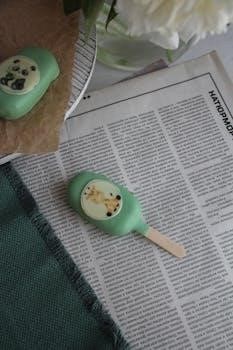popsicle stick catapult instructions pdf

Ready to build your own popsicle stick catapult? This guide offers clear instructions‚ combining fun with STEM learning. Discover how to construct a simple catapult using craft sticks‚ rubber bands‚ and a spoon. Download the PDF for easy-to-follow steps‚ perfect for hands-on projects.
Basic Materials for a Popsicle Stick Catapult
To embark on your popsicle stick catapult adventure‚ gather these fundamental materials. You will need several standard-sized popsicle sticks‚ also known as craft sticks‚ which will form the structural components of your device. Secure a handful of robust rubber bands; these provide the essential elastic force for launching projectiles; A plastic spoon will act as the launching arm‚ cradling the ammunition. Additionally‚ consider having masking tape on hand to assist with temporary adjustments or securing elements. For the projectile itself‚ you could use cotton balls‚ mini marshmallows‚ or even small wads of tin foil. Some designs may incorporate bottle caps‚ offering a more defined projectile holder. Ensure you have a flat working surface and possibly scissors for cutting tape or adjusting materials. With these basic supplies‚ you are well-prepared to begin building a functional and engaging popsicle stick catapult. Remember to work carefully and consider safety precautions when constructing and using your catapult. These materials are commonly found around the house or can be easily purchased at a craft store‚ making this project accessible and fun.
Building the Fulcrum
The fulcrum is a crucial element of your popsicle stick catapult‚ serving as the pivotal point around which the launch arm rotates. To construct the fulcrum‚ begin by gathering five small popsicle sticks. Carefully stack these sticks together‚ ensuring they are aligned neatly. Once stacked‚ use two rubber bands to tightly secure the ends of the stack. These rubber bands should be wrapped firmly‚ creating a stable and cohesive bundle of popsicle sticks. This stacked structure will serve as the central support for your catapult‚ enabling the lever action. The tighter the rubber bands‚ the more stable the fulcrum will be. Take care to position the rubber bands near the very ends of the stacked sticks‚ preventing them from slipping. The fulcrum is essential for transferring the elastic potential energy from the rubber bands into kinetic energy that launches the projectile. A well-built fulcrum ensures consistent and effective launches. It should be sturdy enough to withstand repeated use and provide a solid base for the launch arm to operate from‚ and the entire construction of the catapult depends on the stability of the fulcrum.
Creating the Launch Arm

The launch arm is the part of the catapult that directly interacts with the projectile‚ converting stored energy into motion. For a simple design‚ use a single‚ large popsicle stick as the primary launch arm. Alternatively‚ a plastic spoon can be attached to the end of a popsicle stick to create a cup for holding projectiles‚ this modification can enhance the launching efficiency by providing a more secure hold. To prepare your chosen launch arm‚ ensure that it is free of any splinters or sharp edges. If using a spoon‚ position it so that the bowl is facing upwards‚ ready to cradle the projectile. The connection point of the spoon to the popsicle stick should be secure‚ using rubber bands or tape for stability. When using just a popsicle stick‚ it should be sturdy to withstand the force of launch and bend. The length of the launch arm will affect the distance the projectile is thrown‚ so experimentation may be necessary to find the optimal length for your catapult. The launch arm acts as a lever‚ magnifying the force applied by the rubber bands for a more powerful launch. Make sure it is flexible enough to bend and release stored elastic potential energy.
Assembling the Base
The base of your popsicle stick catapult provides the structural foundation and stability needed for effective launching. Begin by creating a solid platform using several popsicle sticks. A common approach is to form a triangle using three sticks‚ securing the corners firmly with rubber bands or glue. This triangular shape provides excellent stability and helps prevent the catapult from tipping during operation. Another method involves stacking multiple sticks together to create a thicker‚ more robust base. For this approach‚ use several popsicle sticks‚ layering them one on top of the other‚ and securing them with rubber bands at both ends. This creates a flat base that can be placed on any surface. Ensure that the base is as stable as possible to prevent wobbling; The base must also be aligned properly so it does not get in the way of the launch arm movement. The size of the base can also be adjusted to enhance stability. The base needs to be strong enough to withstand the forces of launching‚ especially when using stronger rubber bands. The base is crucial for a successful and consistent catapult performance.
Securing the Launch Arm to the Fulcrum
Properly securing the launch arm to the fulcrum is crucial for ensuring your popsicle stick catapult works effectively. This connection is where the launching power originates‚ so it needs to be stable yet allow for movement. Typically‚ the launch arm is a single popsicle stick or a plastic spoon attached to a popsicle stick. The fulcrum‚ which serves as the pivot point‚ is often a stack of popsicle sticks bound together. To secure the launch arm‚ insert it between the popsicle sticks of the fulcrum‚ near the top. The launch arm should be able to move freely up and down‚ pivoting on the fulcrum. Rubber bands are most commonly used to secure the launch arm; they should be wrapped tightly around the fulcrum and the launch arm. The rubber bands provide the tension needed for launching. Ensure that the launch arm is positioned correctly; it should not be too loose or too tight. Adjust the placement of the rubber bands to ensure smooth movement. The goal is to create a joint that is strong enough to hold the launch arm but flexible enough to allow it to pivot and launch projectiles. The proper attachment of the launch arm to the fulcrum is essential for both power and accuracy.
Adding a Projectile Holder

Adding a projectile holder to your popsicle stick catapult is essential for accurate and consistent launches. The projectile holder acts as a secure place to hold your chosen projectile before releasing it. A common method is to use a plastic spoon‚ attaching it to the end of the launch arm. The spoon’s concave shape perfectly cradles small items like cotton balls or mini marshmallows. Another approach is to use a small bottle cap glued to the end of the launching stick‚ creating a small cup-like holder. This is particularly effective for holding small‚ round projectiles. When attaching the projectile holder‚ ensure it is securely fastened to the launch arm. Glue or strong tape can be used for this purpose‚ depending on the materials you are using. The placement of the holder is also important; it should be positioned to allow for a smooth release of the projectile during the launch. Consider the size and shape of the projectiles you plan to use when selecting and attaching the holder. A well-designed projectile holder is crucial for launching your projectiles with precision and achieving the desired distance. It should be robust enough to hold the projectile firmly until launch.
Using Rubber Bands for Power
Rubber bands are the crucial element that provides the power for your popsicle stick catapult. They work by storing elastic potential energy when stretched‚ which is then released as kinetic energy to launch your projectile. To effectively use rubber bands‚ you need to secure them properly to the catapult frame. Typically‚ you’ll use rubber bands to connect the launch arm to the base‚ creating the tension needed for propulsion. The number of rubber bands and their tightness will directly affect the power of your catapult. More rubber bands or tighter bands generally result in a more powerful launch. When attaching the rubber bands‚ make sure they are wrapped securely around the popsicle sticks. Loose rubber bands may slip or not provide consistent power. You can also experiment with different types and sizes of rubber bands to achieve varied launch distances. Using multiple bands can also spread the force more evenly and prevent the catapult from breaking. It is important to regularly check the rubber bands for wear and tear‚ as they can weaken with repeated use. Remember‚ the rubber band’s tension is what makes the catapult work‚ so proper attachment and adjustment are essential for optimal performance.

Alternative Catapult Designs
Beyond the basic popsicle stick catapult‚ there are numerous alternative designs you can explore. One variation involves creating a triangle-based catapult‚ using three sticks to form a triangular base‚ offering a more stable structure. Another design uses a shoebox as the base‚ creating a larger and potentially more powerful catapult. You can also incorporate LEGO bricks to build a catapult frame‚ allowing for more complex and customizable designs. Some advanced designs even utilize cut popsicle sticks at angles to create a more robust launch arm. These modifications can change the catapult’s mechanics and throwing distance. Additionally‚ you can experiment with different types of launching arms‚ such as a plastic spoon or a bottle cap‚ to hold projectiles. Another approach involves altering the fulcrum by using a stack of popsicle sticks tied together at one end or using a pencil instead. Each of these changes will affect how the catapult functions and how far the projectile will travel. These alternative designs offer opportunities to understand physics principles and encourage creativity.
STEM Principles and Catapults
Building a popsicle stick catapult provides a hands-on way to explore key STEM principles. This simple machine beautifully demonstrates the concept of a lever‚ where force is applied to move a load over a fulcrum. The catapult also illustrates the principles of energy transformation‚ converting potential energy stored in the bent launch arm to kinetic energy when the projectile is released. Through experimentation‚ you can learn about projectile motion‚ including factors like trajectory and launch angle that influence distance. The use of rubber bands highlights elasticity and the storage of potential energy. Furthermore‚ constructing the catapult encourages problem-solving and critical thinking as you adjust variables like rubber band tension‚ the arm length‚ and projectile weight. This activity also integrates engineering design principles‚ where you test and refine your design to achieve optimal performance. By observing these mechanics‚ you can understand how force‚ motion‚ and energy work together in a real-world context‚ making learning engaging and practical.

Experimenting with Projectiles
Once your popsicle stick catapult is built‚ the fun continues with experimenting with different projectiles. This is a great opportunity to observe how various factors affect the distance and trajectory of launches. You could try using small objects like cotton balls‚ mini marshmallows‚ or even small paper wads. Note how the weight of the projectile impacts the distance it travels – lighter objects might fly further while heavier ones might need more force. You can also experiment with the size and shape‚ observing how aerodynamics come into play. For instance‚ spherical objects might fly more consistently than irregularly shaped ones. Consider testing projectiles with different textures to see if friction plays a role. Observe how the angle of your launch arm and the force applied by the rubber bands influence the projectile’s path. This process encourages scientific observation and data collection‚ as you record your findings and make informed adjustments to improve performance. It’s a great way to learn about physics in an interactive and engaging way.
Troubleshooting Common Issues
Building a popsicle stick catapult can sometimes come with its set of challenges; One common issue is the catapult not launching projectiles far enough. This can often be attributed to insufficient tension in the rubber bands. Try tightening them or adding more to increase the power. Another issue could be the launching arm slipping; ensure it’s securely attached to the fulcrum with strong rubber bands. If your catapult is unstable‚ double-check that the base is properly assembled and sturdy. Sometimes‚ projectiles might not be launching consistently – this could be due to an uneven launch surface. Make sure the base is flat. If the launch arm is too flexible‚ consider adding another popsicle stick for extra rigidity. If your projectiles are not landing where expected‚ adjust the angle of the launch arm and the tension of the rubber bands. Ensure all connections are tight and secure before testing. By systematically checking these areas‚ you can effectively troubleshoot common catapult issues and get back to launching successfully.